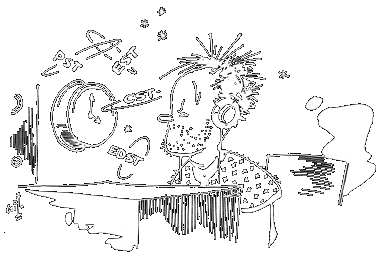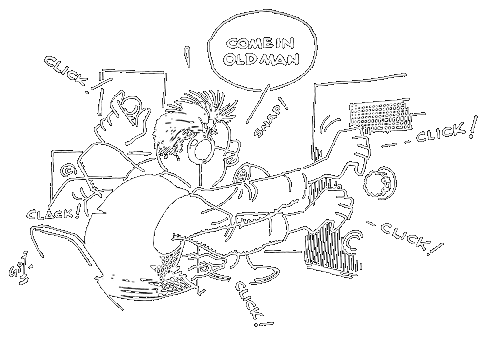
Project Perseids
- 1957
Some Results
Achieved and Observations Made During the August Meteor Shower
BY WALTER J.
MORRISON,* W2CXY
If you can’t work them during the Perseids of August, you may never work them
at all.
 This
conclusion has been reached by most of the really serious 144 Mc meteor-scatter
enthusiasts. The other showers (For a schedule of meteor showers see W4LTU’s
article, “V.H.F. Meteor-Scatter Propagation,” April, 1957, QST) have their
points, and they give you more time to work at this fascinating aspect of 144 Mc
DX, but the Perseids have everything. With this in mind, schedules were firmed
at W2CXY with several stations around and beyond the 1000 mile
[1609km] mark for the
period Aug. 9 through 14. Attempts were also made to line up tests at
transcontinental distances, but for one reason or another all bogged down. This
conclusion has been reached by most of the really serious 144 Mc meteor-scatter
enthusiasts. The other showers (For a schedule of meteor showers see W4LTU’s
article, “V.H.F. Meteor-Scatter Propagation,” April, 1957, QST) have their
points, and they give you more time to work at this fascinating aspect of 144 Mc
DX, but the Perseids have everything. With this in mind, schedules were firmed
at W2CXY with several stations around and beyond the 1000 mile
[1609km] mark for the
period Aug. 9 through 14. Attempts were also made to line up tests at
transcontinental distances, but for one reason or another all bogged down.
Equipment at
this end consisted of a pair of 4-125As, driven by a modified 522. The power
input, 1000 watts, delivered about 500 watts to the antenna, with the balance
serving to keep moisture out of the equipment and to heat the basement. The
antenna has 4x 10 element Yagis, each 16 feet long, in a 12x 12 foot square, fed
with 7/8 inch Styroflex coax. The receiver is a W2AZL converter working into the
14 Mc, range of a 75A4 receiver, equipped with a Heath Q Multiplier and a
Panadaptor. Power at other stations ranged from 80 to 1000 watts. Antennas were
both multiple Yagi and collinear types, with 16 and 32 element collinears
predominating.
The adding of
new states being a prime objective, the following stations were lined up for
schedules: W0YSJ, North Dakota; W0BJV, South Dakota; W0IAY, with alternates
W0WRT and W0EMS, Nebraska; W0IHD, with alternates W0s RUF LFE TGC and K0DOK,
Missouri; W0ZJB, Kansas; W5JWL, Arkansas; W5AJG and W5IRP, Texas; W5FAG, New
Mexico; and W7FGG, Arizona. Results were as follows:
Aug. 9 W5FAG,
0700-0730 — 3 very short no-intelligence (ni.) bursts heard.
Aug. 10 W0YSJ,
W0BJV, W0IAY, W0IHD, W5JWL, W5FAG. Due to error in time each station was called
one hour ahead of schedule. Results nil! Suggestion: Adopt a standard time for
all meteor-scatter skeds. [Amen! W2CXY was not the only one who did some calling
and listening at wrong times. You can be awfully foggy at 0400EST! - Ed.]
This error at
least allowed time for cooperating stations to zero in on the frequency, but
imagine the confusion that could occur if skeds are kept at wrong times and the
sending station uses only his own call, as has been done by some. Suggestion:
Every transmission, at least until identification is made both ways, should
include both the call of the sending station and that of the station with whom
the schedule is kept. [Editor's note - An absolute must; identification both
ways, always difficult enough, is impossible without this. Furthermore, it’s
illegal not to send both calls at least once every 10 minutes.]
Error in time
discovered after 4 hours and 40 minutes, and sked with W5JWL was kept, 0640 to
0700; several n.i. only heard. W5FAG, 0700-0830; W7FGG, 0830-0900; W5AJG,
0900-093-; W7FGG, 1000-1030; all nil heard. Reports from the other ends: W0IAY,
W0WRT and W7FAG, nil. W0IHD had receiver trouble; alternate W0LFE heard 15
bursts, longest 8 seconds. W5JWL heard the wrong-time transmissions, logging
W2CXY as calling W5FAG during W5JWL sked time. W5AJG - few n.i.
Aug. 11 W0YSJ,
0000-0100 - several n.i. W0BJV, 0100-0200 - 4 n.i. W0IAY, 0200-0310 - nil.
W0HlD, 0400-0505 - heard complete call group loud and clear. Recorder tape
fouled and broken; no record for posterity. Also heard key-down burst 3 minutes
after conclusion of sked. W5JWL, 0505-0545 - several exchanges of calls, reports
and R’s for QSO. Jay had listened to earlier skeds and heard many good bursts,
so was ready. Reception at W2CXY included more than 15 bursts, longest 25
seconds. W5FAG, 0600-0730 - several n.i. W7FGG, 0730-0800 - nil. W5AJG,
0800-0830 - several n.i., plus one 12-second screamer, believed to have been
from W5FAG.
W0IAY reports
no results, but did hear W2ORI. W0HID says nil. WOLFE heard 33 bursts, best
being 10, 15, 22 and 40 seconds. W5AJG heard few n.i., but worked W2ORI, and’
heard W8PT, the latter with first doppler frequency shift heard by W5AJG. W7FGG
nil.
 Aug. 12 W0YSJ,
0000-0100 - exchanged complete call groups, reports and strings of R’s for first
N. Dak. - N. J. 144 Mc QSO. W0YSJ reports no success with W2NLY on preceding
schedule. Question: with W2NLY having what is probably the world’s largest
2-meter beam, does this mean that a very large and sharp array can be a
liability in m.s. work? K2GQI, with only two Yagis, was heard by W0YSJ, even
without schedule. W0BJV, 0110-0215 - complete exchange for first S. Dak.-N. J.
QSO. Best bursts heard from W0BJV were two of 10 and 31 seconds duration. W0IAY
not heard, 0215-0300. W0IHD, 0400-0500 - exchange could have been completed in
20 minutes or less, but held back on “R” in order to further tape Charles’
signal. Some 24 bursts were heard, longest 15 seconds, but much information
copied, due to excellent keying at 25 to 30 w.p.m. by W0IHD. Clean and fairly
high - speed keying definitely an asset in ms. work. W5FAG, 0600-0730, and
W7FGG, 0730-0755 - nil. Aug. 12 W0YSJ,
0000-0100 - exchanged complete call groups, reports and strings of R’s for first
N. Dak. - N. J. 144 Mc QSO. W0YSJ reports no success with W2NLY on preceding
schedule. Question: with W2NLY having what is probably the world’s largest
2-meter beam, does this mean that a very large and sharp array can be a
liability in m.s. work? K2GQI, with only two Yagis, was heard by W0YSJ, even
without schedule. W0BJV, 0110-0215 - complete exchange for first S. Dak.-N. J.
QSO. Best bursts heard from W0BJV were two of 10 and 31 seconds duration. W0IAY
not heard, 0215-0300. W0IHD, 0400-0500 - exchange could have been completed in
20 minutes or less, but held back on “R” in order to further tape Charles’
signal. Some 24 bursts were heard, longest 15 seconds, but much information
copied, due to excellent keying at 25 to 30 w.p.m. by W0IHD. Clean and fairly
high - speed keying definitely an asset in ms. work. W5FAG, 0600-0730, and
W7FGG, 0730-0755 - nil.
At 0755
observed S5 pips on Panadaptor at 144.005 and 144.052. These turned out to be
W5DFU and W9ZIH, latter remaining for 2 minutes. W0YSJ reports W2NLY heard fb.
W9WOK says W2CXY was heard too much during his skeds. W9WOK worked W4AIB, Aiken,
S. C., and W7JRG, Billings, Mont., however, a nice spread.
Aug. 13 W5IRP,
0030-0200 - several n.i.; QRN from power line. W0IAY, 0200-0300 - one ni. No
skeds 0300-0345; called CQ last 30 seconds of each minute with no response.
W0TGC 0355-0430 - several parts of calls; sked might have worked if for longer
period. K0DOK, 0430-0500 - nil. W5IRP, 0500-0600 - few n.i. W5FAG, 0600-0645- 2
ni. W7FGG, 0730-0800; W5AJG, 0800-0835; W7FGG, 0900-0930 - all nil. W5IRP
reports 3 S7 bursts, 5 to 10 seconds. W0TGC heard nothing. K0DOK heard several
n.i. on the W0TGC sked, but none on his. He also heard several 2 to 3 second
bursts nearly every minute of W2CXY-W5IRP sked, 0530 to 0600, when the W2CXY
beam was well off the line to Missouri. W5IRP heard nothing. W5AJG heard one
complete set of calls, strength weak.
Aug. 14 W5IRP,
0030-0200 - nil. W0IAY, 0200-0300 - heard “W2” and a few n.j. W0TGC, 0345-0430 -
parts of calls and many ni. K0DOK, 0430-0500, W5IRP, 0500-0615, W0ZJB,
0700-0730, and W5AJG, 0755-0835 - all nil. W5IRP heard nothing on either sked.
W0IAY also heard nothing. W0TGC identified W2CXY immediately and received both
calls and reports later. He also copied W2CXY for 20 seconds solid during the
K0DOK sked. W0ZJB and W5AJG both heard nothing.
In summary,
successful contacts were made with W0YSJ, 1200 miles
[1931km], 100 watts, 32el. beam;
W0BJV, 1180 miles [1899km], 100 watts, 16 el.; W0IHD, 880 miles
[1416km], 80 watts, 32el.; and
W5JWL, 1150 miles [1851km], 450 watts, 16el. W5FAG., 1800 miles
[2897km], was heard. All contacts
were tape recorded, and copies of the tapes are available to anyone.
As with the
1956 Perseids, the maximum distance seems to exceed the maximum aurora distance
by some 300 miles [483km]. Contacts at 900
[1448km] to 1200 miles
[1931km] seem similar to single-hop sporadic-E. The margin of the signal
over the noise is often good, and such contacts can be made with medium power
and moderately-sized beams, with some perseverance and prior scheduling. High
power, and antenna systems having a real gain of 17 to 18 dB or more are a considerable help, even when such equipment
is used at only one end of the path. The higher-powered end of the circuit will
then drive through more consistently, and the operator can get more information
across to help the other fellow. If procedure follows exactly the method firmed
for the schedule, the lower-powered station will then be able to interpret the
needs of the higher for completion of the contact.
Work at 1400
miles [2253km] is undoubtedly possible, but just a little improbable when running
schedules of one hour or less. Contacts may be possible at 1800 miles
[2896km] or more,
but they are unlikely because of their dependence on rare high-velocity burnouts
that occur at heights of 300 km. or greater. Extensive checks with well-equipped
stations at these distances bear this out. In 1956 W7LEE had a 48element array.
W7FGG has a 64elements at 85 feet and 4x 5element Yagis at 45 feet. W5FAG has a
16 dB tiltable array and a 48element collinear.
Conditions are
often good enough during the Perseids and possibly other major showers so that
contacts should be possible without prior scheduling, if some standard calling
systems could be agreed upon. During nonschedule periods, for example, stations
west of the Mississippi might call CQ during the first 30 seconds of each minute
and listen for replies from east of the Mississippi, or for CQs from that half
of the country, during the second half of each minute. The best-equipped
stations might stand a fair chance of making random contacts in this way. Once
calls were exchanged, the balance of the QSO could be carried out in the
more-or-less standard meteor-scatter routine (“World Above 50 Mc. March, 1957,
QST.).
A Panadaptor
is a great help in the band- scanning that must be done to take advantage of
such a calling system. The method at W2CXY is to scan from 144.0 up to 144.5 and
back, using a 50 kc sweepwidth. Any promising pips can be zeroed in at once,
and then all the operator has to do is wait for the next burst.
Best direction
from W2CXY appears to be a few degrees south of west, though no obstructions
interfere in other directions. A virtual meteor pipeline is in evidence to
Missouri and Oklahoma. Anyone in doubt can see for himself; there are plenty of
fellows in those states who want schedules in the future. Intensive use of
meteor-scatter techniques should make a practical maximum of 37 states workable
from the East Coast. For a strategically-located W5, W9 or W0, a 144-Mc. WAS is
not beyond the realm of possibility, and 40 or more are well within the reach of
many others.
A comparison
of DX possibilities of meteor scatter and aurora is of interest, in view of
recent auroral DX of record proportions. W4LNG, Georgia, at 700 miles
[1126km], has yet
to be worked via meteors, but W4MBR, running only 50 watts in the same state,
was worked via aurora Sept. 4 and 13. K0DOK, not even heard via ms., and W0TGC,
both 900 miles [1448km] with whom we couldn’t quite make it during the Perseids, were
both worked via aurora on the 13th. Conversely, stations at greater distances,
such as W5AJG, W5DFTJ and W5JWL, all active during the big auroras recently,
were not heard here except by meteor skeds during the Perseids. At the moment it
appears that for extreme DX meteor scatter is one’s best bet, but for ranges out
to a maximum of perhaps 1000 miles [1609km], and with stations in the higher geomagnetic
latitudes, auroral reflection may provide the best chance for solid contact.
That
tropospheric openings have a potential for extreme DX is proven by the KH6UK -
W6NLZ work on 144 Mc. And the tropospheric session of Sept. 17 provided a chance
to work out almost to the distances thus far covered only by ms. Perhaps
consistent effort on all three fronts will someday help us to reach that
numerically not-too-distant goal of a 144 Mc WAS!
QST November 1957
For OK2KKW web rewrited OK1TEH in 2008
|